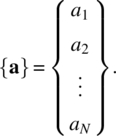AppendixMathematical Preliminaries
Since vector calculus and linear algebra are used extensively in finite element analysis, it is worth reviewing some fundamental concepts and recalling some important results that will be used in this book. A brief summary of concepts and results pertinent to the development of the subject are provided for the convenience of students. For a thorough understanding of the mathematical concepts, readers are advised to refer to any standard textbook, such as Kreyszig1 and Strang.2
A.1 VECTORS AND MATRICES
A.1.1 Vector
A vector is a collection of scalars and is defined using a bold typeface3 inside a pair of braces, such as
In eq. (A.1), {a} is an N‐dimensional column vector. When the context is clear, we will remove the braces and simply use the letter “a” to denote the vector. The transpose of a above will be a row vector and will be denoted by aT.
By default, in this text all vectors are considered as column vectors unless specified. For simplicity of notation, a geometric vector in two‐ or three‐dimensional space is denoted by a bold typeface without braces:

where a1, a2, and a3 are components of the vector a in the x‐, y‐, and ...
Get Introduction to Finite Element Analysis and Design, 2nd Edition now with the O’Reilly learning platform.
O’Reilly members experience books, live events, courses curated by job role, and more from O’Reilly and nearly 200 top publishers.


